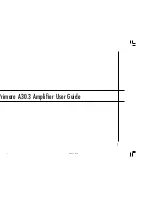
7
GAIN MATCHING
In any audio system, the goal is to reach maximum input and output levels without distortion or clipping.
The engineers at KICKER have taken the guesswork, and hassle, out of matching the output voltage of
your source unit to the amplifi er with the Gain Matching feature.
1kHz @ 0dBFS, 50Hz @ 0dBFS, 1kHz @ -10dBFS, 50Hz @ -10dBFS, 1kHz @ -5dBFS, 50Hz @ -5dBFS
These test tones are sine waves meant to provide a consistent signal for the KX amplifi er to reference.
The different recording levels are designed to give you the perfect gain match for your application.
0dBFS:
Designed for audiophile applications to give you distortion free audio output with the most
dynamic range.
-5dBFS:
Designed for normal/daily applications, there will be less dynamic range but higher potential
audio output levels. With this set up you can get some occasional clipping from the amplifi er.
-10dBFS:
Designed only for Subwoofer applications, there will be less dynamic range but higher potential
audio output levels. With this set up you can get some clipping from the amplifi er.
Afterwards, use the following procedure to accurately Gain Match your amplifi er(s):
1. Disconnect the speakers from the KX amplifi er.
2. Set all EQ and crossover settings to fl at on your source unit.
3. Play the downloadable fi le from KICKER.
4. Turn the source unit up to 3/4 volume.
5. Increase the gain of the amplifi er until the Gain LED turns on.
6. Decrease the gain of the amplifi er until the Gain LED turns off.
All level matching circuitry in the KX amplifi ers is at the beginning of the signal chain. If you are going to
use features like bass boost, it may be necessary to readjust the gain to a lower setting to compensate
for increased output at those frequencies.
Once the amp and source unit are gain matched, you will want to make certain you are not overdriving
your speakers. Use the following procedure:
1. Set the source until volume to 0.
2. Reconnect the speakers to the KX amplifi er.
3. Slowly increase the volume level of the source unit as you listen for audible distortion.
4. If you can hear clipping, decrease the gain of the amplifi er until it is gone.
GAIN
MATCH
KICK EQ Bass Boost Control:
The variable bass boost control on the side of the KXMA400.4 amplifi er
is designed to give you increased output, 0–18dB, at 40Hz. The setting for this control is subjective. If you
turn it up, you must readjust the input gain control to avoid clipping the amplifi er.

























